Belarusian School of Icon Painting
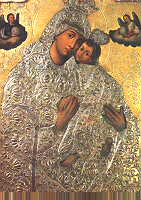
|
Over
the 10 centuries of Christian history of Belarus (see
Belarusian historical timeline) Belarusians have formed their own unique school of
icon painting. Belarusian icon painters were drawing their experience from both Eastern
Byzantean tradition and Western Roman Catholic tradition. We have collected in this page
several remarkable masterpieces from the Belarusian School of Icon Painting. Depicted to the left is The Virgin of Compassion
- an icon painted in 1774. |
|
Belarusian School of Icon Painting ranks high in Slav
culture. The traditions of Bysantine and Ancient Rus' art, which were assimilated by the
culture of Belarus eldest towns (IX - XIV cc.) have been united with the stylistic
features of the Western European art - the Renaissance ( XIV - XVI cc.), Baroque (late XVI
- XVIII cc.), Classicism (later half of the XVIII c.).
The roots of this phenomena lie in
the originality of historical development of
Belarus. Being situated at the juncture of the Latin West and the Orthodox East,
Belarusian lands were in the heart of the Grand Duche of Lithuania (1240-1772), which has
formed later a Commonwealth state with the Kingdom of Poland - Rzhechpospolita
Polsko-Litewska (1569-1772). In such conditions took place the formation of the Belarus
nation, language, culture. And the icon painting played a sterling part in this process.
In the early ages of Christianity
in Belarusian lands it was customery that icon masters would travel among different duches
(freely or by force). Thus an icon painting tradition over entire lands of modern Belarus,
Russia, Ukraine, Serbia, Bulgaria and Greece was shaping as one. The same was true for the
church architects. They were often brought from distant lands. Such it is believed that
Kalozha Church in Hrodna was built in XII c. by enslaved builders from Novgorod Duchy, now
in Northern Russia. In XVI c. when Muscovy started to attack Belarusian Lands after
ridding itself from Tartars, many Belarusian craftsmen, including icon painters were
captured by Russian oprichniks and forced to move to Moscow. An entire region near Kremlin
- Meschanskaia Sloboda - was settled by Meschane - craftsmen from Belarusian cities -
"Mesta".
The formation of independent
Belarusian school of icon painting traces back to the XV-XVI cc. At this time Belarusian
painters having accumulated the Byzantine traditions and painting technology, acquired
their individual manner, found types, characters, their own vision of colouring, their own
iconographic versions.
The restored monuments of the
XV-XVI cc - The Virgin Hodigitria of Slucak and The Virgin Hodigitria
of Smaliensk - are traditional in iconography but unusual for the works of Slavonic
cicrle. They differ with decorative solutions used in the nimbuses, which could be traced
to Italo-Crete tradition. Unlike in Slavic icon painting tradition Belarusian masters
start using the light-and-shadow treatment of the form. They begin to model the volume,
render the depth and perspective. These novelties are well illustrated by such XVI c.
Belarus masterpieces as St. Paraskeva and Christ
Pantokrator. The background of these icons, as well as Italian, Spanish, German,
French, Polish, Czech altar painting and polyptychs of the XIV-XVI cc., is filled with a
fretted ornamentation done in large patterns imitating Italian textiles.
|
|
XVI century
Click on
the images for more information
The Belarus monuments have merged
the Orthodox iconography with noval technical and stylistic methods of the Europena
Renaissance painting. These tendencies expressed in a compromise bond of novel and
medieval modes of thinking, found their bright reflection in the works produced
by the prominent Belarus printing pioneer,
enlightener, philosopher Francisk Skaryna, who was born in Polacak (c. 1490-not later
1551).
At the same time, the XVI c.
monuments have already traces of the late Renaissance - Mannerism. Thes tendencies,
expressed in a compromise bond Baroque, which becomes one of major trends in Belarus
culture during XVII-XVIII cc.
In the XVII c. icon painting, particularly, in the
works by an anonimous artist of Malorita (1648-1650), by Pyotr Yeuseevich of Halynets
(1649), etc., prevail characteristics typical to Baroque: life observations, illusionism,
pathetics, popular major colouring.
Enriching the canonic schemes with
realia made the icons be genre scenes based on the Biblical stories - the facet which
strikingly distinguishes Belarus icon painting from more traditional art of Ancient Rus'.
Preserving the Orthodox canon came
also out of political considerations that found their expression in the struggle against a
forced spreading of Lublin Union (1596) with Polish Kingdom and spreading of Catholicism.
The XVII-XVIII cc. icon painting became one of the forms of struggle for the national
culture and language, acquired a political character. Owing to the archive materials and
remained ensembles (in the towns of Mahilyow, Davyd-Haradok, Shereshava) one can trace the
evolution of iconostases and reveal their originality, which manifested itself in
multitiers of icons, a peculiar solution of the deesis order, a greater attention to the
ornamentation in the styles of Baroque and Classicism.
XVII century
XVIII century
XVIII century
The main challenge for Belarusian
icons in the XX century was to simply survive the Wars, the Communists, the Art thieves.
As you could read from the descroiptions majority of the icons shown here survived 70
years of Communist struggle against religion through being converted from religious
objects into the objects of art. They have been removed from the churches into museums.
Many churches with all the icons were destroyed by Soviet government - simply blown up
with all the content. Many ancient icons were used for firewood. Many icons were lost during the wars - WWI, Polish-Soviet War and WWII.In the
70-ies and 80-ies many icon were stollen from the churches by art thiefs, who were $elling
them as art objects to the West. In a sense museums and thieves have saved many priceless
ancient icons from destruction.
But today is
the time to return icons to the churches. While having a quality of art objects, icons are
first and foremost sacral religious objects that must be treated with proper piety and
respect. Many of these icons have a long history of miracles and magic, associated with
them. Returning the icons to believers is a transcendental act of the returning of the
lost Spirit to Belarusians.
Traditional Presentation of Icons
to Public in Churches and Residencies
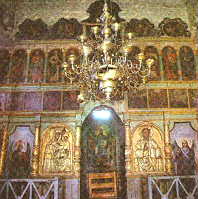
St. George Church in Davyd- Haradok, built in late XVII c.
|
A typical arrangement of icons in Eastern Orthodox Christian churches is shown on
the left and on the right. Iconostas is a multi-row (up to 7 rows are known) alignment of
icons above the altar. Many individual icons of were aligned in the right and left wings
of the Church and had their strict functional designations. Such a candle is supposed to
be lit at the Crucifix image in the left wing to pary for the deceized. Concerns of
motherhood were usually addressed to Virgin Mary icon. St. George and St. Nicolas were are
protectors, etc. |
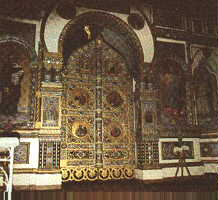
Pakrowskaia Church in Baranavichy built in 1924-1931
|
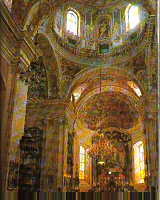
Niasvizh Roman Catholic (Jesuit)
Cathedral of the Body of Christ, built in 1581-1593
|
The Roman Catholic churches of Belarus are different in their moderate
decoration. The statues of Saints are often used instead of icons or paintings. Below is
characteristic interior of Belarusian Roman Catholic Cathedral - Farny Cathedral in
Hrodna, famous for its wooden sculptures. |

Farny Roman Catholic (Jesuit)
Cathedral in Hrodna, built in 1622-1763.
|
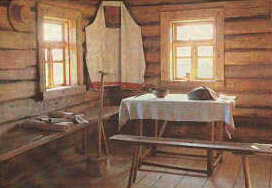 |
When displayed in residence the
icon is usually hung in Belarus in the opposite corner from the entrance door. The
entering person usually finds an icon visually and crosses himself three times blessing
the Lord and the house. The
picture on the left is from a National Ethnographic Museum. It depicts a typical late XIX
c. - early XX c house in Belarusian village. One can find the icons in the corner of the
room anywhere in Belarusian houses nowadays too. As I type this text a reproduction of The Virgin Hodigitria of Kalozha covered with hand made Belarusian
"rushknik" textile is overlooking me from the corner of my room :) |
Glossary:
"Unwrapping" icons. Most of the
famous icons in Belarus were wrapped in a silver cladding - "Ryza", often gold
plated - see the first illustration on this page - The
Virgin of Compassion. The pilgrims, who were coming tosee, touch and even
kiss the icons, were bringing their offerings to the Saints, depicted on icons. In time
the particular icon would become surrounded with different prescious stones, metals,
objects of decorative art. Eventually only faces and hands of the Saints would be left
uncladded with silver, gold and prescious stones. When the icons were restored in XX c.
they had to be removed from silver cladding - "unwrapped" - which required a
great skill of restorer.
"Chiton" - long dress
traditionally worn in Antique Greece and Middle East.
References used in page:
Currently these pages are heavily based on
the materials of an excellent Belarusian Icon review given in this book:
"Ikanapis Belarusi XV-XVIII stahoddziau"("Icon
Painting of Belarus in XV-XVIII centuries"), Minsk - 1994, publishing house
"Belarus", Ed.: N.F. Vysockaia.
ISBN 5-338-01183-2
We are hoping to add more materials from other sources in
future
Links:
Icon Painting in Belarus, 15 th -
18 th centuries
by Leon Lauresh from Lida, Belarus, which contains images of 92 Belarusian icons scanned
from the above book. And so you can have much broader acquaintance with Belarusian Icon
from there. And, of course, buying the book itself
would be the best option.
Study of
distribution of the icon-painting topics in the ancient Belarusian art
by V.G. Karelin (The National Art Museum of Belarus) and N.P. Melnikov (Art History,
Ethnography and Folklore Institute of the National Academy of Sciences of Belarus)
 This file is a part
of the Virtual Guide to Belarus - a collaborative
project of Belarusian scientists and
professionals abroad. VG brings you the most extensive compillation of the
information about Belarus on the Web.
This file is a part
of the Virtual Guide to Belarus - a collaborative
project of Belarusian scientists and
professionals abroad. VG brings you the most extensive compillation of the
information about Belarus on the Web.
Please send your comments to the authors of VG to
Belarus 
History | Statehood | Culture | Law
and Politics | Cities
| Nature and Geography | Travel | Global Resources | Dictionaries | Chernobyl | Genealogy | Industry | New
©1994-01 VG to Belarus
Disclaimer
